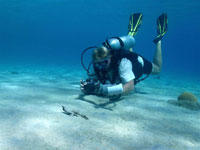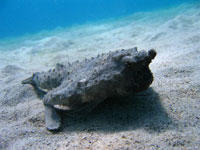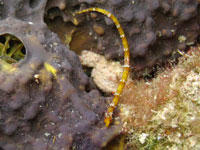Author: Paige Switzer, REEF Intern
7/7/07 marked a successful GAFC Kickoff Party here at the REEF Headquarters, while across the country in Seattle, people gathered to celebrate the art, ecology, and culture of Puget Sound at the Puget Soundscape. Environmental groups were welcomed to this event to share each of their unique contributions to conservation. The renowned Foster/White Art Gallery of Seattle arranged an event in the afternoon dedicated to linking the gap between art and nature through “watchable wildlife.” Master Artist, Tony Angell spoke at the event along with our Director of Science, Christy Semmens, who shared information about the Great Annual Fish Count and REEF’s mission . The gallery generously agreed to donate a portion of the proceeds from the event to REEF.
So far, over half of the registered events have already been completed, and we are eager to hear back of their success. We would like to extend great thanks to all of the coordinators, and best wishes to those coordinators whose events are coming up very soon. Events and their locations still to come include:
California: Discount Dive Trips for the entire month of July hosted by Paradise Dive Club, Santa Barbara, CA
US Northeast/New England: Fish Count Dives onJuly 28th conducted by the New England Aquarium Dive Club, Gloucester, MA;
Caribbean and Bahamas: Weekly multimedia fish ID classes held at CoCo View Resort, Roatan, Honduras through August 4th.
For all of you Great Annual Fish Fanatics who have participated in fish seminars across the country, thank you for your support and don’t forget that you can complete fish survey dives anytime!
Author: Lad Akins, Special Projects Coordinator
If you’ve read recent REEF releases, you’ve heard the news that Indo-pacific lionfish are now well established along the eastern US coast and throughout the Bahamas. REEF has been and continues to work with researchers to learn as much as we can in order to most effectively address the invasion. Since January of this year, REEF has organized and led 5 week-long projects in the Bahamas to document the extent of the invasion and gather samples and information needed by NOAA and Bahamian researchers.
Here is what we’ve found:
- Lionfish are being found as deep as 350’ and as shallow as 2’.
- Lionfish have been documented in almost all habitat types including patch reefs, artificial reefs, walls, and even mangroves
- Lionfish have been captured as small as 25mm and as large as 389mm
- Most lionfish have been in the 200mm size range
- Lionfish prey has included fish, shrimp and crabs
- Lionfish appear to have high site fidelity (they don’t move much)
- Lionfish appear to be reproducing year-round in Bahamian waters
- The lionfish invasion appears to have come from a small founding population (not a large release of many fish)
- Stomach content analysis has documented lionfish predation of cleaner fish
- Every site visited in the Berries in April contained lionfish – most contained multiple fish
Here is what we are working on with NOAA and Bahamian researchers:
- Continuing documentation of lionfish distribution and impacts on local fish populations
- Documentation of lionfish at cleaning stations and subsequent predation on cleaning fish
- Predation by other species on lionfish
- Genetic relationships of lionfish in one area (NC, northern Bahamas) to those in other areas (S Bahamas) to determine dispersion pathways.
- Parasitology of lionfish (they appear to have few parasite compared to native fish)
- Larval occurrence at different locations using larval light traps
- Juvenile recruitment preference using small shallow water nets and trawls
- Trap preference of adult lionfish
- Lionfish recruitment rates to sites denuded of lionfish (i.e., recruitment pressure)
- Recruitment of lionfish to artificial structures
- And more!
As part of this effort, REEF has planned more research efforts through the end of 2007. Each project will include participation of scientists, researchers, and/or REEF staff. For a list of upcoming projects visit http://www.reef.org/exotic/lionfish/ or e-mail lad@reef.org
Author: Leda A. Cunningham, Executive Director
In late June, the Cornell Lab of Ornithology (CLO) hosted the first ever Citizen Science Toolkit Conference in Ithaca, New York. Widely known for projects like FeederWatch and the Great Backyard Bird Count, the CLO is a pioneer in bringing people closer to nature through cooperative research, cutting edge technology and innovative science programs across many natural science fields. Leda Cunningham and Dr. Christy Semmens represented REEF at the 3-day meeting, where fifty leaders of citizen science organizations around the world – from worm watchers to bird counters to star gazers – came together to build a toolkit for citizen science practitioners and others seeking to engage volunteers in meaningful science activities.
There is some debate about what citizen science is, not to mention what it does. Many participants noted that “volunteer monitoring” more accurately captures the nature of their programs (much like the REEF Volunteer Fish Survey Project) while others thought that volunteers fill more of a role than just data collectors and should be involved in all parts of the scientific process, beginning with posing the research question. The group periodically split into five focus groups and reconvened at the end to present a model based on each group’s focus area: Education, Evaluation and Impact, Community Building, Technology and Cyberinfrastructure, and Research and Monitoring. The resulting Toolkit will include resources, recommendations, and case studies from each of these areas, as well as a key to existing citizen science programs. Christy participated in a panel on the impacts of citizen science and presented examples of how REEF data are used by resource agencies and scientists. She presented details of how REEF volunteers helped identify a hotspot of non-native fishes along the south Florida coast and the resulting management actions of the Florida Fish and Wildlife Conservation Commission, the important role that REEF data can play as a fisheries-independent source of data for the development of stock assessments and fisheries management plans, the discovery of new species by several REEF members, and the value of using our most experienced divers (the Advanced Assessment Team) to conduct annual monitoring of selected sites inside and around no-take marine reserves.
REEF was proud to contribute its fourteen years of experience building the Volunteer Fish Survey Project to the group discussion. Many citizen science organizations deal with the same issues of volunteer recruitment, recognition and retention, engaging the “real” science community, standardizing data collection methods and measuring success. REEF has addressed many of these issues with innovative strategies that may be adopted by other citizen science initiatives: engaging the private retail sector (dive shops) to recruit volunteers within a target audience (scuba divers and snorkelers), developing strong partnerships with science and resource management agencies (such as university-based researchers and the National Marine Sanctuary Program), 5-level expertise testing (in fish identification) to assist with quality control, a published standardized data collection method and the Advanced Assessment Team as an incentive for volunteers to become more proficient surveyors and a measuring stick for training programs.
For more information on the conference or Citizen Science Central, the CLO’s initiative to provide information for practitioners and volunteers,
click here. Look for the Citizen Science Toolkit, a robust and practical framework for citizen science program development, implementation, and evaluation, in the fall 2007.
Author: Dr. Christy Pattengill-Semmens, REEF Director of Science
WASH Nearshore Symposium
REEF’s Director of Science, Dr. Christy Pattengill-Semmens, was an
invited speaker at the Temperate Reef Resources Symposium held at the University of Washington in early June. Christy spoke on the role that volunteers play in generating needed data for managing temperate reefs, and used examples from REEF experiences and projects in three west coast National Marine Sanctuaries, the Olympic Coast, Monterey Bay, and
the Channel Islands. To date, over 10,000 REEF surveys have been conducted in coastal areas along the west coast of the US and Canada.
Channel Islands Shore to Sea Lecture Series
In early July, Christy was the featured speaker for the monthly Channel Islands Shore to Sea Lecture Series, which is sponsored by the Channel Islands National Marine Sanctuary and Park. Christy spoke on REEF surveying inside and outside of the marine reserve network that was
implemented around the Channel Islands in 2004. Much of these data are
collected using REEF’s Pacific Advanced Assessment Team aboard the Channel Islands National Marine Sanctuary’s Research Vessel Shearwater.
Flower Garden Banks National Marine
Sanctuary fisheries impact workshop
Christy also presented information on the REEF
Volunteer Survey Program at a recent priority issues workshop on fishing impacts for the Flower Garden Banks National Marine Sanctuary. The workshop was used to discuss the possibility of Flower Gardens National Marine Sanctuary implementing experimental no-take zones within the Sanctuary. Christy presented information about REEF's volunteers 14 year long monitoring of reef fish at the Flower Garden Banks National Marine Sanctuary, and how this data can provide a valuable baseline to be able to measure the effects of any future no-take zones that might be implemented in the Sanctuary.
Author: Leda A. Cunningham, Executive Director
On Saturday, July 14th, seventy members of the REEF Sustainers Club (annual donors of $1,000 or more), key partners and long-time REEF friends convened in Key Largo, Florida to celebrate fourteen years of REEF accomplishments over some diving and a sunset dinner. Paul Humann, Ned DeLoach and other Board, staff and Advisory Panel members were on hand to lead guests on some spectacular morning REEF survey dives while Amy Slate and her stand-up staff at the Amoray Dive Resort generously hosted the lodging and dinner party. “The event was just beautiful.” Said long-time REEF surveyor Elaine Morden, of Homestead, Florida. “It was great to connect with old REEF friends and see some new faces.”
The bi-annual Sustainers Event is a chance for REEF to bring together important members of the REEF family to thank them for their contributions and share successes of the organization over the years. This year, REEF was proud to recognize Linda Schillinger for achieving one of the highest REEF honors: admission into the Golden Hamlet club for those who have conducted 1,000 or more REEF surveys. We were also proud to recognize Key Largo resident and REEF office volunteer Audrey Smith for nearly ten years of regular service to the organization by quality-checking survey scanforms before they are uploaded to the REEF database. REEF was itself bestowed with an honor by Sanctuary Friends of the Florida Keys Director Glenn Patton: SFFFK generously gave a gift of support for the Great Annual Fish Count this year to help underwrite the costs of public outreach and education events.
By virtue of a Paul presentation and applause vote, the group answered the perennial question “What is the most beautiful fish in the Caribbean?” Out of thirty possibilities ranging from the spotfin hogfish to the fairy basslet, the spotted eagle ray won a narrow victory over close rivals the queen angelfish and queen triggerfish. Ned enthralled the group with fish behavior anecdotes from as far afield as Indonesia and gave updates on valuable REEF programs ranging from the Grouper Moon Project to the Exotics Species Sightings Project.
All agreed that the only thing hotter than the event itself was the Florida sun in July. With the heat index topping 100 degrees, no one needed a better excuse to indulge in a new REEF-inspired cocktail, the Indigo Hamlet, a unique and diversified alcoholic concoction for our wonderful sustainers to imbibe in while enjoying the sunset! Many thanks to all who made this a Sustainers Weekend to remember. See you at the next one . . .
For information about joining the Sustainers Club, please contact Leda Cunningham: Leda@reef.org or (305) 852-0030.
Author: Lad Akins, Special Projects Coordinator
To those who are in the know, St Vincent is considered the critter capital of the Caribbean. To those who watch fish, it is known that the rare is commonplace and that the fishwatching is unlike any other location in the Caribbean. REEF’s data from the June Field Survey supports those claims. With a team of 13 divers, the REEF group recorded an astounding 243 species, more than 65 of which were unlisted “write-ins” on the survey forms.
Diving with Bills Tewes at Dive St Vincent, long time REEF supporter and widely regarded “Caribbean Character”, the team split up on two boats and survey sites around the southwest end of the island. Long-time REEF expert Franklin Neal provided an extra special view from above and into shallow water as he snorkeled, while other team members spent hours on each dive exploring varied habitats and depths.
Special finds during the week would take an entire newsletter to list, but there were a few fish that stood out including the still undescribed Bluebar Jawfish on most sites, five frog fish on one dive, multiple black brotula, various pipefish commonly sighted and the largest spotfin gobies (10 inches?!) we’ve ever seen. The fish of the week may well have been the Golden Hamlet that Bill pointed out as his favorite fish and the species that adorns the cover of Reef Fish Identification.
The diving was bottom time unlimited and many dives exceeded two hours finishing in shallow water. Habitats were varied and visibility ranged from good to excellent on all of our dives. REEF is already planning our next Field Survey to dive St Vincent in August of 2008. The project will be led by Paul Humann and will be a must for any serious fishwatcher. For more details, contact Joe@reef.org
Author: Marissa Nuttall, REEF Intern
In the first few weeks of July we have started receiving reports of several Manta ray sightings at French Reef, near Key Largo, Florida. Mantas are found in the temperate, tropical, and sub tropical waters world wide. However, sightings in Florida waters are uncommon. Some observers saw the mantas swimming in large vertical loops, leading them to think that these animals were coming into the shallow reefs to feed on coral spawn.
Mantas inhabit near-shore and pelagic waters, and can grow up to ~14ft in width. They are primarily filter feeders, using large cephalic fins located on the head to help 'funnel' plankton into their mouths.
So, if your diving in the Florida Keys keep an eye out for one of these magnificent animals swimming by - and be sure to record it on your survey!
Author: Linda Ridley, REEF Member
"Did you ever have a fish experience that both excited and sadden you?"
That feeling recently happened to me at the dive site Kalli's Korner in Bonaire. My husband, Chile, and I were having a great day of diving with our friends Bryan and Phyllis McCauley in their boat, Pufferfish. Towards the end of our second dive that day, I noticed a pair of eyes peeping out of some coral rubble. As I watched suddenly a small eel darted out and raced few feet before hiding again. I was immediately intrigued and, using my rattle, got my buddy Phyllis' attention. Pointing out the location, we watched as once again the little conger eel slipped out of his cover and moved away. We slowly began to approach in hope of a better look. The process continued as we sought to identify him and he continued his trek. Each time we were able to get a bit closer and look for characteristics. Finally he seem comfortable enough to look at us, as we looked at him. Suddenly, a barred hamlet appeared above him and scooped him up. Imagine our shock and horror!!! Anger raced through my body and instinctually I reached for my dive knife and took off after that (blank blank) hamlet. The chase continued as the hamlet, with his full tummy, eluded me and viewed me as if to say 'why are you after me?' What was my plan I thought later? Well, I only know if I had caught the sucker, oops fish, he would have been disemboweled in the search for the little conger eel. The sound of laughter underwater reaches me. By this time, my dive buddy is in stitches as I sheepishly return. Later research found a margaintail conger that matched our descriptions.
Now as I continue my search for what I hope are his companions, I will be keeping a wary eye out for hamlets in the surrounding area. So that’s my fish tale and now for the question: Should you report to REEF a fish, found, identified but not longer living in the underwater world?
You can bet I did.
Author: Todd Fulks, REEF Member.



